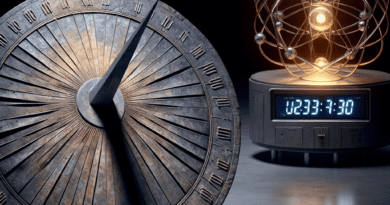Coordinated Universal Time
As an adventure seeker, you’re no stranger to different time zones and having to adjust your watch as you hop from one exciting destination to the next. Whether you’re catching a sunrise in Rome or chasing the northern lights in Iceland, time plays a crucial role in your plans. That’s where Coordinated Universal Time (UTC) comes into play — a time standard designed to be accurate and reliable for international timekeeping. So, sit back and learn about the fascinating world of Coordinated Universal Time, and how it can make your future travels run even more smoothly.
Definition of Coordinated Universal Time
Coordinated Universal Time, often abbreviated as UTC, is the standard time system used around the world. It’s the ticking heartbeat of modern international timekeeping and serves as the basis for civil time.
Meaning of Coordinated Universal Time
What does Coordinated Universal Time mean to you? It’s the time standard against which all other time zones in the world are set. It’s like the boss of all time, the one standard that everyone follows, irrespective of their geographical location.
How is it Calculated?
So, you might be wondering, how is Coordinated Universal Time calculated? It’s pretty impressive. Coordinated Universal Time combines highly precise atomic time with somewhat less precise but astronomically determined Universal Time. The atomic time component accounts for the precise seconds while the Universal Time provides the day-to-day adjustment to align with the Earth’s rotation.
Purpose of Coordinated Universal Time
But what’s the purpose of Coordinated Universal Time? For one, it ensures we all have a common frame of reference. It’s vital for fields like navigation, computing, time-stamping events, and many aspects of international regulation and coordination.
History of Coordinated Universal Time
Timekeeping has come a long way, and the history of Coordinated Universal Time is just as fascinating as the concept itself.
Development and Establishment
The development and establishment of Coordinated Universal Time is a testament to the progress of human innovation. Its creation was implemented in 1960 by the International Time Bureau, which took into account both the variations of the Earth’s rotation and the absolute frequency of atomic clocks, striking the best balance between astronomical and atomic times.
Changes and Adjustments Over Time
Over the years, there have been changes and adjustments to Coordinated Universal Time. Introduced in 1972, leap seconds are added to keep UTC within 0.9 seconds of mean solar time, accommodating minor variations in the Earth’s rotation.

Comparison with Greenwich Mean Time
Now, you might have heard of Greenwich Mean Time (GMT) and wonder how it relates to Coordinated Universal Time. Let’s compare the two.
Similarities with Greenwich Mean Time
There are indeed similarities between Greenwich Mean Time and Coordinated Universal Time. Both are based on the 0-degree longitude meridian, referred to as the Prime Meridian. Also, in regular civil contexts, they are often used interchangeably as they have nearly the same mean solar time.
Differences from Greenwich Mean Time
However, they do have key differences. The primary contrast between Coordinated Universal Time and Greenwich Mean Time is their basis of timekeeping. While UTC is atomic time, adjusted to match solar time via leap seconds, GMT is solely based on Earth’s rotation and is not as precise as UTC.
Usage of Coordinated Universal Time
Because of its precision and universality, Coordinated Universal Time gets a lot of usage around the globe.
Utilization in Different Fields
Various fields utilize Coordinated Universal Time. If you work in telecommunications, computing, navigation, weather forecasting, or many sectors of the international bureaucracy and law, you’re likely using UTC every day.
Global Standard Time
Driven by its precision and uniformity, Coordinated Universal Time also functions as the global standard time. It unifies timekeeping throughout the world, ensuring harmonization of clocks and time references across countries and regions.

Importance in Aviation and Space Travel
When it comes to aviation and space travel, Coordinated Universal Time is more than important—it’s crucial.
Time Reference in Flight Operations
In aviation, Coordinated Universal Time acts as the primary time reference. When pilots talk to air traffic control, they use UTC to avoid any confusion that could arise from varying local times.
Significance in Space Missions
In space missions, Coordinated Universal Time is significant. Not only is it used to plan events and schedule communications with spacecraft, but it also helps in accurate data logging and timestamping of the mission events.
Role in Technology and Digital Systems
Technology and digital systems are other spheres where Coordinated Universal Time plays a key role.
Application in Computer Systems
Computer systems worldwide use Coordinated Universal Time as their reference, ensuring synchronized time across all linked systems. From your personal computer to global server networks, UTC is at work.
Time Synchronization in Networks
Network synchronization is another area where Coordinated Universal Time is crucial. It ensures that time-sensitive transactions, like stock trades or digital broadcasts, are executed timely and correctly across different geographical locations.

Importance in Scientific Studies
Coordinated Universal Time is not just about ticking clocks; it holds high significance in various scientific studies.
Role in Astronomical Observations
In astronomical observations, using Coordinated Universal Time is standard practice. Efficiently comparing observations from different places on Earth requires a common time standard, and that’s where UTC comes in.
Use in Climate and Weather Forecasting
Coordinated Universal Time is also used in climate and weather forecasting. The ability to accurately timestamp meteorological events helps in tracking weather changes and predicting future weather conditions.
Coordinated Universal Time in Daily Life
While Coordinated Universal Time is extremely important in various industries, you’ll find it affects daily life in many ways too.
Influence on International Business and Finance
On a global stage, international business and finance heavily depend on Coordinated Universal Time. It assists in coordinating economic activities, trade, and financial transactions globally.
Impact on Global Telecommunications
Global telecommunications are also impacted by Coordinated Universal Time. When you’re making an international call or sending an email, the timestamps are often based on UTC to keep things consistent.
Understanding Time Zones
A key to understanding Coordinated Universal Time is understanding time zones.
Concept of Time Zone
The concept of time zones is pretty straightforward. The Earth is divided into 24 time zones, each spanning 15 degrees of longitude. The time in each zone is offset from Coordinated Universal Time by a certain number of hours.
Relation of Time Zones with Coordinated Universal Time
Time zones have a direct relation to Coordinated Universal Time. UTC is the time standard from which all time zones count their offset, making it the master reference for establishing local time around the globe.
Challenges and Controversies Related to Coordinated Universal Time
With all its importance, Coordinated Universal Time has also had its share of challenges and controversies.
Leap Seconds Issue
The introduction of leap seconds has been an issue of debate. They’re necessary to keep Coordinated Universal Time in line with the Earth’s slightly irregular rotation, but they can cause trouble for some communication and computer systems.
Debates on Reforms and Changes
There are ongoing debates on reforming and changing how Coordinated Universal Time is determined. Some experts argue for a more streamlined time system without leap seconds, while others stress the importance of keeping our time tied to the rotation of our planet.



